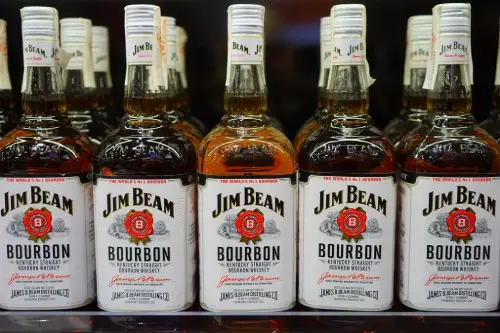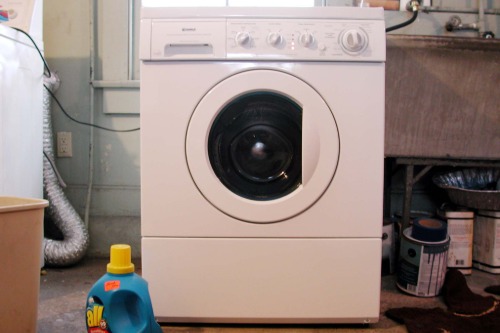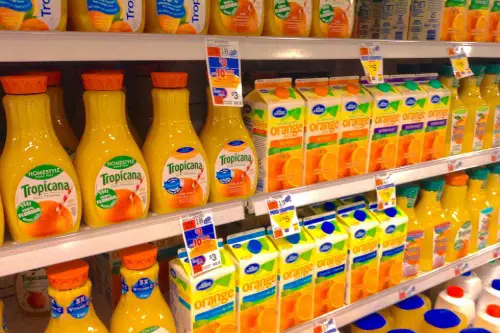1. Harley-Davidson Motorcycles

If your dream ride suddenly seemed way more expensive in Europe, it’s not just inflation—it’s tariffs, according to John Keilman of The Wall Street Journal. Harley-Davidson bikes exported to Europe cost thousands more, and the company even considered shifting some production overseas to avoid the hike. It was a gut-punch for a brand so closely tied to American identity.
For European buyers, the added cost made these bikes a lot less appealing, cutting into Harley’s international sales. For U.S. riders, the price hikes showed up in more subtle ways, like scaled-back features or limited editions. Tariffs weren’t just background noise—they reshaped how and where these iconic bikes were made and sold. The open road got a little more complicated.
2. Almonds

Almonds might seem like an unlikely victim of geopolitics, but they were hit hard when China retaliated against U.S. tariffs. As the world’s biggest almond exporter, the U.S.—especially California—took a major hit following the new administration’s tariff war, Maliya Ellis of The San Francisco Chronicle explains. That meant higher prices in Asian markets and a sudden oversupply back home.
Farmers saw their export markets shrink overnight, and many were forced to lower prices domestically just to stay afloat. The ripple effects also meant changes in packaging and distribution to try to attract new markets. If your almond butter seemed cheaper for a while, that might’ve been why. Trade wars have a sneaky way of showing up in your pantry.
3. Bourbon Whiskey

That bottle of Kentucky bourbon you saw in a German airport just shot up in price, and it’s not because it got fancier. The European Union targeted American whiskey in retaliation for steel tariffs, according to Jennifer Rankin and Lisa O’Carroll of The Guardian. This wasn’t just symbolic—it hit one of the most culturally American products right in the bottle.
U.S. distilleries like Maker’s Mark and Jim Beam suddenly found themselves priced out of key markets. Domestic sales couldn’t fully make up for lost exports, so some companies delayed expansion plans or scaled back production. You might’ve noticed fewer discount deals at home, too. That nightcap started tasting a little more expensive.
4. Washing Machines

Remember when washing machine prices spiked in 2018? That wasn’t just because of new features or fancy steam settings—it was tariffs. The U.S. imposed a 20% tariff on imported washers to protect domestic manufacturers like Whirlpool. In response, foreign companies like LG and Samsung raised prices and even built U.S. factories to avoid the duties.
It was a textbook example of how tariffs can lead to higher consumer prices in the short term. The average price of a washer jumped by around $86, and dryers weren’t spared either. You probably felt that extra cost during your last Home Depot run. Protectionism has a price, and in this case, it was literally paid at checkout.
5. Soybeans

Soybeans don’t exactly scream “headline material,” but they became a trade war flashpoint when China—America’s largest soybean buyer—slapped retaliatory tariffs, Rosa de Acosta of CNN explains. Almost overnight, U.S. farmers found their biggest market drying up. Prices for soybeans plummeted, leading to billions in lost revenue and emergency aid from the federal government.
Some farmers had to let crops rot or switch to other plants entirely. Meanwhile, China turned to Brazil and Argentina to fill the gap, reshaping global trade routes. Even if you’re not eating tofu or edamame daily, these shifts had major effects on the U.S. economy. It showed just how intertwined agriculture and geopolitics really are.
6. Blue Jeans

Even your denim isn’t safe from a trade spat. When the EU drew up its list of retaliatory tariffs, Levi’s blue jeans made the cut, with a 25% tariff added to U.S.-made pants imported into Europe. The move was as symbolic as it was financial—nothing says “America” like a pair of Levi’s.
While Levi’s has factories around the world, the tariffs still disrupted their supply chains and led to strategic reshuffling. Some models became pricier in European stores or harder to find altogether. So if you noticed slimmer stock on your Paris shopping trip, this might be why. Even fashion gets political sometimes.
7. Cranberries

Cranberries probably weren’t the first thing that came to mind during a trade war, but they got caught in the crossfire too. The EU and China both included them in their lists of retaliatory tariffs, which hurt American growers—especially in Wisconsin and Massachusetts. Cranberry exports fell, and producers scrambled to find new markets like India and South Korea.
To prevent a surplus glut, the U.S. even offered growers incentives to scale back production. Meanwhile, domestic prices saw brief drops before stabilizing again. That holiday cranberry sauce may have been cheaper—or more expensive—depending on where you bought it. Not even Thanksgiving was spared.
8. Steel

Steel was actually the match that lit the whole trade war fire when the U.S. imposed a 25% tariff on imported steel in 2018. It was meant to protect American steelmakers, but the fallout was broader than expected. Domestic producers like U.S. Steel and Nucor did benefit at first, but downstream industries—think auto and construction—saw raw material costs soar.
That meant higher prices for everything from cars to kitchen appliances. Some American manufacturers even laid off workers or moved production overseas to cope. You didn’t need to buy raw steel to feel its impact—it snuck into the price tag of everything it touches. And that’s a lot of things.
9. Cars

If you’ve tried to buy a car since 2018 and felt like you needed a second mortgage, tariffs were partly to blame. Although a full-blown auto tariff didn’t materialize, the industry was rattled by steel tariffs and threats of duties on imported cars and parts. Automakers preemptively raised prices and restructured supply chains.
Some foreign brands scaled back investment in U.S. plants, while American car companies warned of long-term cost increases. Even used cars became pricier as demand surged in an uncertain market. The trade war didn’t just affect new vehicle prices—it reshaped the whole auto ecosystem.
10. Lobsters

Maine lobstermen were blindsided when China slapped a 25% tariff on U.S. lobster imports in 2018. The Chinese market had been booming, with exports soaring year after year. Then the tariff hit, and Canadian lobsters—tariff-free—suddenly had the upper claw.
American lobster exports to China dropped by over 80%, and fishermen scrambled to find buyers in Europe and the Middle East. Some boats stayed docked longer, while prices at U.S. grocery stores fluctuated. So if your lobster dinner felt a bit cheaper or more local, that’s probably why. One retaliatory tariff changed the tides.
11. Motorboats

Recreational boats, especially smaller motorboats made in the U.S., were hit by EU tariffs in 2018 as part of the retaliatory package. American boat manufacturers like Brunswick Corporation saw European sales tank almost overnight. With tariffs of up to 25%, their products were no longer competitive abroad.
Many companies cut back on international marketing or delayed product launches. U.S. consumers saw some price increases too, as companies tried to recover lost profits domestically. What was once a summer luxury became a lesson in global economics. Even the lake wasn’t safe from the trade war.
12. Oranges and Citrus Fruit

When China and the EU imposed tariffs on U.S. agricultural goods, oranges and other citrus fruits got squeezed—literally and figuratively. California’s citrus industry, which relies heavily on exports, found itself blocked from key overseas markets. Tariffs of up to 15% made American citrus less appealing abroad.
This led to oversupply in the domestic market and volatile pricing at home. Growers struggled to stay profitable, even as consumers occasionally saw better deals. Your morning orange juice might’ve felt like a bargain—or a trade war casualty. The global market was not feeling very sunny.
13. Paper Products

You probably didn’t think your notebook or printer paper had a geopolitical backstory, but here we are. China, the EU, and others placed tariffs on certain paper goods in retaliation to U.S. steel and aluminum duties. American paper manufacturers took a hit, especially those focused on exports of specialty papers and pulp.
Prices rose both abroad and at home, and supply chain hiccups made some products harder to find. For businesses ordering paper in bulk, the cost increases were more than just annoying—they were budget-breaking. All of a sudden, buying paper got a lot more complicated than just picking the cheapest ream.
14. Pecans

Here’s a nutty one—literally. U.S. pecans were hit with a 15% tariff by China, and that was a big deal because China had become the second-largest export market for American pecans. Georgia and Texas growers were especially affected, and the price per pound dropped sharply in the U.S. as demand abroad dried up.
Some growers left pecans unharvested because it cost more to pick them than they were worth. Others pivoted to domestic marketing or diversified their crops altogether. So if you saw more pecans popping up in American snack aisles, now you know why. The global trade war quietly cracked this nut wide open.


